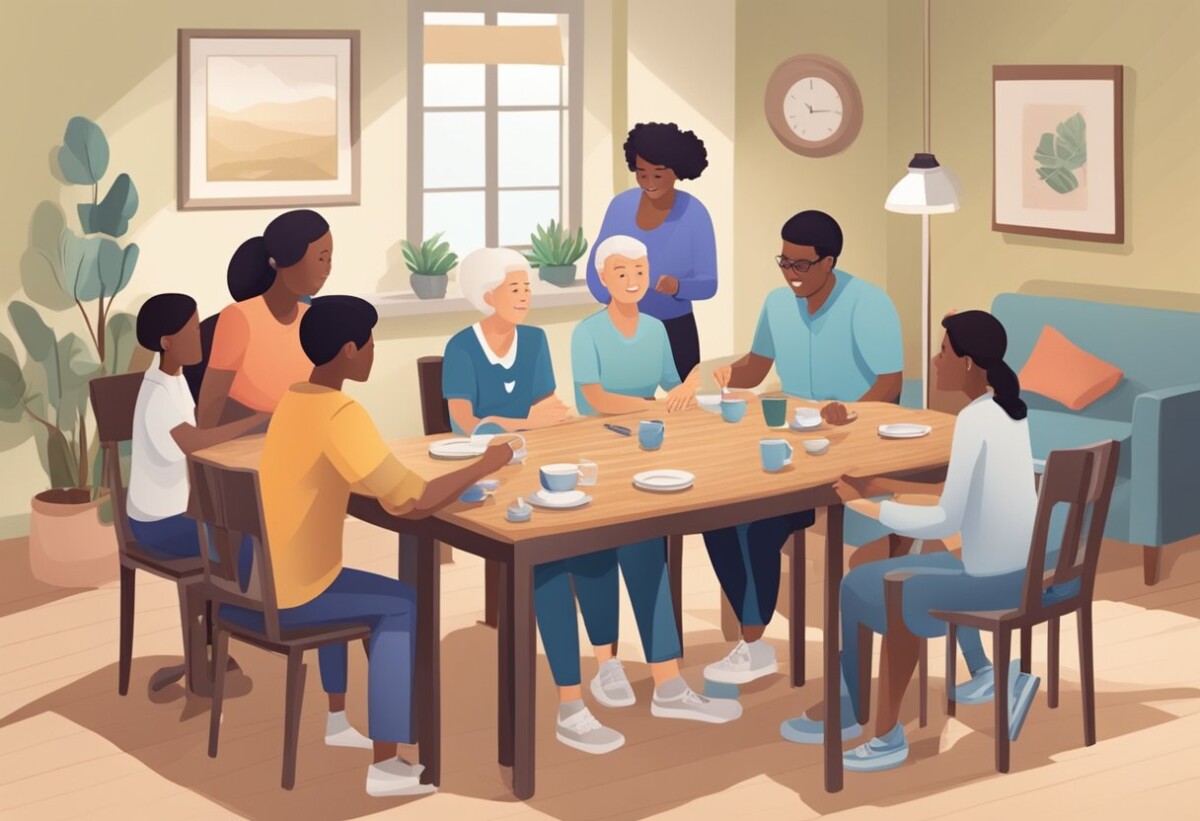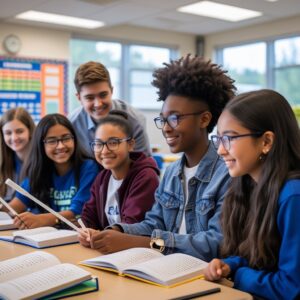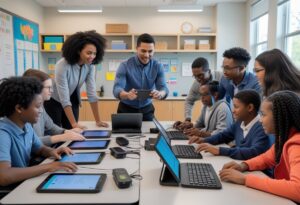Family and Caregiver Support for Deaf-Blind Individuals: Essential Strategies and Resources

Family and Caregiver Support for Deaf-Blind Individuals
Deaf-blind individuals and their families face a unique set of challenges and opportunities. Supporting their diverse needs requires a comprehensive understanding of available resources and community networks. Providing family and caregiver support for deaf-blind individuals through these resources and support networks can significantly enhance their quality of life. At New England Low Vision and Blindness, we are committed to offering leading-edge assistive technology and training to bring hope and improve the daily lives of these individuals.
Family involvement is crucial in navigating the complexities of deaf-blindness. Organizations like the National Family Association for DeafBlind offer invaluable resources, bringing families together to share experiences and advice. Such community support fosters an environment of collaboration and learning essential for improving educational and personal outcomes.
By leveraging tools and support systems, families and educators can create inclusive environments that empower deaf-blind individuals to thrive. Our dedication at New England Low Vision and Blindness extends beyond technology, focusing on building networks that inspire confidence and independence within this vibrant community.
Discover NuCaption: Real-Time Solutions for the Deaf-Blind Community
 Empower communication with NuCaption, the innovative tool designed specifically for the Deaf-Blind community. This real-time captioning solution transforms the way individuals interact with the world, providing clear, accessible, and immediate text translation during conversations. Whether you’re at a meeting, in class, or enjoying social events, NuCaption bridges the gap and fosters inclusive environments.
Empower communication with NuCaption, the innovative tool designed specifically for the Deaf-Blind community. This real-time captioning solution transforms the way individuals interact with the world, providing clear, accessible, and immediate text translation during conversations. Whether you’re at a meeting, in class, or enjoying social events, NuCaption bridges the gap and fosters inclusive environments.
Learn more and explore how NuCaption can transform your experience today. Visit our product page NuCaption – Real-Time Solutions for the Deaf-Blind Community or watch our video.
Understanding Deaf-Blindness
At New England Low Vision and Blindness, we strive to provide assistance and hope to those who are visually impaired. Deaf-blindness combines hearing and visual impairments, presenting unique challenges and making the need for tailored support essential. Below, we explore its characteristics and the specific challenges and needs faced by individuals.
Characteristics of Deaf-Blindness
Deaf-blindness is characterized by a simultaneous impairment in hearing and vision, which affects communication, development, and education. According to the IDEA definition, these impairments create severe challenges that cannot be addressed solely through services for just deafness or blindness.
Individuals with deaf-blindness experience difficulties that are not merely additive but exponential, impacting every aspect of daily life. Unique characteristics can include reduced ability to understand auditory and visual information. These limitations demand specialized approaches to support learning and independence.
Effective communication strategies, such as tactile sign language and assistive technology, are essential. Devices that enhance hearing and vision can empower users by improving interaction with their environment, promoting greater autonomy.
Challenges and Needs
Deaf-blind individuals face significant hurdles in communication, access to information, and mobility. These challenges necessitate robust support from family, caregivers, and educators. Customized educational plans are crucial, integrating both hearing and visual aids to facilitate learning. Access to resources like the National Center on Deaf-Blindness and state Deafblind Projects can provide invaluable support for families and educators.
Social integration also requires dedicated effort. Strategies to promote interaction include the use of assistive devices and ensuring inclusive environments. Training for families and caregivers is vital, offering insights into effective communication methods and fostering an understanding of how best to support those with these disabilities. By addressing these needs, we can improve the quality of life and opportunities for individuals with deaf-blindness.
Role of Family in Support Dynamics
Family support plays a crucial role in the lives of individuals who are deaf-blind. The connection with family members not only provides emotional backing but also impacts the practical aspects of day-to-day life, ensuring that individuals receive the comprehensive care and assistance they need.
Navigating Family Responsibilities
Families of deaf-blind individuals face unique challenges in balancing responsibilities among members. Each family is different in how it distributes caregiving tasks, which may include communication assistance, daily routines, and scheduling medical appointments.
Communication can be a significant area of need. Families often develop specialized communication methods, which can include sign language and tactile methods, to interact effectively with their deaf-blind members. The involvement in these roles can sometimes require guidance from professionals, which can be found from providers like New England Low Vision and Blindness, who offer leading-edge training in assistive technology and communication strategies.
Impact on Siblings and Family Dynamics
Siblings of deaf-blind individuals experience a variety of emotions and adjustments. As families navigate these dynamics, it’s not uncommon for siblings to take on roles similar to secondary caregivers. This can include helping with communication or simply being a strong emotional support system.
Balancing these roles can affect the siblings’ social lives and academic commitments. Family dynamics are often shaped by birth order and individual strengths, impacting how each member contributes. When caregivers and siblings work together, they create a more harmonious environment that fosters growth and development for the deaf-blind individual and their family as a whole.
Educational Considerations and Resources
In our continuous efforts to support the education of individuals who are deaf-blind, we focus on tailored planning, collaborative strategies, and the use of assistive technology. These elements ensure that each person receives personalized learning experiences suited to their unique needs.
Education Planning for Deaf-Blind Individuals
Education planning for those who are deaf-blind requires an individualized approach. Each Individualized Education Program (IEP) must be carefully crafted to address the unique sensory challenges faced by these learners. Parents, caregivers, and teachers collaborate to identify specific goals and accommodations.
We find that involving specialists in the planning process enhances the educational outcomes. Input from experts in low vision and deaf-blindness ensures that appropriate resources and strategies are included in the educational plan. Consistent review and adjustment of these plans are crucial to keeping pace with the learner’s development.
Collaborative Approaches in Learning
Collaboration forms the backbone of effective education for individuals who are deaf-blind. Teachers, specialists, and family members work together to create a supportive learning environment. This partnership extends beyond the classroom to include community activities that promote social and personal development.
Structured teaching methods and project-based learning benefit students by allowing them to engage in interactive and meaningful experiences. We ensure that educators are supported with ongoing training on the latest approaches and techniques. Opportunities for peer interactions also play an essential role, helping bridge the learning gaps.
Role of Assistive Technology in Education
Assistive technology transforms the educational landscape for students with deaf-blindness. At New England Low Vision and Blindness, we provide leading-edge technology solutions that aid in communication, learning, and daily living skills. Devices such as braille displays, screen readers, and specialized software are tailored to meet the sensory and learning needs of each individual.
Training on the use of these technologies is essential, not just for the students, but also for educators and family members. This holistic approach ensures everyone involved is confident in their use, thereby maximizing the benefit of the technology. These resources empower individuals to access information seamlessly and contribute to their academic success.
Support Networks and Community Resources
We focus on empowering families and caregivers of deaf-blind individuals by providing access to essential support systems. These networks play a crucial role in enhancing life quality and integration into society.
National Family Association for Deaf-Blind (NFADB)
The National Family Association for Deaf-Blind supports families by connecting them to vital resources. Their Adult Life Support Group fosters a sense of community through the Family-to-Family Communities Project, offering opportunities for families nationwide to share experiences and information.
NFADB affiliates offer regional support and hold regular meetings. These gatherings address specific challenges and practical solutions, tailored to the needs of those with family members who are deaf-blind. By facilitating these connections, NFADB strengthens the extended network of support available to families across the nation.
State and National Resources
Various state and national resources contribute significantly to the support network for deaf-blind individuals. In New York, the New York State Deaf, DeafBlind and Hard of Hearing Office connects members with resources that enhance life quality. Programs offered include employment services, advocacy, and community integration support.
The National Center on Deafblindness plays a significant role by providing centralized information and resources accessible to families across the country. Their initiatives include guidance on adapting to the unique needs of deaf-blind individuals, ensuring they receive comprehensive and compassionate care. By utilizing these resources, we can better support the community and improve the lives of those affected by deaf-blindness.
Advocacy and Lifelong Empowerment
In advocating for deaf-blind individuals, it is essential to focus on their empowerment and support. Our expertise in assistive technology helps provide the necessary tools and training, offering a pathway to a more independent and fulfilled life.
Building a Strong Advocacy Foundation
Creating a robust advocacy foundation involves understanding the unique challenges faced by deaf-blind individuals. This means engaging with policymakers and community leaders to push forward initiatives that promote accessibility and inclusivity. Collaborating with organizations that share our mission can amplify our collective voice and create meaningful change.
Another important aspect is education. We must provide information to both caregivers and individuals, empowering them to become advocates themselves. This involves understanding available resources, such as legislative support, and tapping into community networks.
Empowerment Through Self-Advocacy
Empowerment begins with self-confidence and awareness. Encouraging deaf-blind individuals to advocate for their needs is crucial. Teaching communication strategies and offering training on using assistive technology can enhance their voices in society.
Workshops and support groups can also be invaluable. These platforms provide a safe space for individuals to share experiences and learn from others. By fostering a supportive community, we enable deaf-blind individuals to take charge of their lives and advocate effectively for themselves.
Legal Rights and Advocacy Resources
Understanding legal rights is vital for empowerment. Deaf-blind individuals and their caregivers need access to information on laws and regulations designed to protect them. This includes the Americans with Disabilities Act (ADA) and other disability rights legislation.
We offer guidance on navigating these legal frameworks, ensuring compliance and advocating for further legal advancements. Access to advocacy resources, such as those provided by organizations and community programs, equips individuals with the knowledge and tools they need to defend their rights and live empowered, independent lives.
Family and Caregiver Support for Deaf-Blind Individuals
When supporting Deaf-Blind individuals, it is crucial to have access to specialized services and connections with groups that assist these individuals and their families. Understanding the available resources and technologies can greatly enhance the quality of life for both individuals and their caregivers.
What are the primary services provided by organizations that assist Deaf-Blind individuals?
Organizations play a vital role in offering services such as communication support, educational resources, and skills training to enhance independence and confidence. The Center for Deaf-Blind Persons highlights the importance of Support Service Providers, focusing on empowering individuals.
How can families find local support groups for Deaf-Blind individuals?
Families seeking support groups can connect with organizations like VisionAware, which offers a directory of resources tailored to their local regions. These groups provide a platform for networking, sharing experiences, and gaining necessary support.
What assistive technologies are available to support Deaf-Blind individuals?
We at New England Low Vision and Blindness provide leading-edge assistive technologies such as braille displays and screen readers to aid communication and navigation. These technologies help increase independence and interaction with the world.
Who are the key advocates or organizations for specialized education for the deaf?
Many organizations, like the Helen Keller Services, are dedicated to advancing educational opportunities for Deaf-Blind individuals. They focus on specialized training aimed at personal development and educational achievement.
What role do Support Service Providers (SSPs) play in the support of Deaf-Blind people?
SSPs are vital in assisting Deaf-Blind individuals by facilitating communication and day-to-day interactions, enhancing their independence. These providers work closely with individuals to navigate their environments more effectively, as highlighted by the Center for Deaf-Blind Persons.
Can you name a prominent national organization dedicated to serving families with Deaf-Blind members?
Helen Keller Services stands out as a leading organization offering resources and support for families with Deaf-Blind members, focusing on independence and quality of life improvements. They provide comprehensive services and valuable information aimed at empowering individuals and their families.
Experience Empowerment with Our Deaf-Blind Training
Unlock independence and enhance accessibility with our specialized Deaf-Blind Training services. Whether you’re an individual seeking tailored solutions, an organization striving to create inclusive environments, or a caregiver aiming to support loved ones, our training is designed to provide practical tools and strategies.
👉 Learn More & Get Started Today
Discover NuCaption: Real-Time Solutions for the Deaf-Blind Community
 Empower communication with NuCaption, the innovative tool designed specifically for the Deaf-Blind community. This real-time captioning solution transforms the way individuals interact with the world, providing clear, accessible, and immediate text translation during conversations. Whether you’re at a meeting, in class, or enjoying social events, NuCaption bridges the gap and fosters inclusive environments.
Empower communication with NuCaption, the innovative tool designed specifically for the Deaf-Blind community. This real-time captioning solution transforms the way individuals interact with the world, providing clear, accessible, and immediate text translation during conversations. Whether you’re at a meeting, in class, or enjoying social events, NuCaption bridges the gap and fosters inclusive environments.
Learn more and explore how NuCaption can transform your experience today. Visit our product page NuCaption – Real-Time Solutions for the Deaf-Blind Community or watch our video https://youtu.be/gGF38aaFfqw



